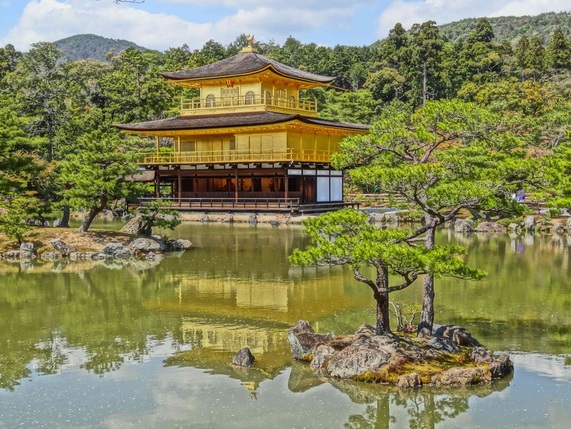
Kinkaku-ji - Temple of the Golden Pavilion
Kyoto and its environs was our last major stop in Japan and many argue it is the most interesting area of the country. The seat of imperial power from 764 until 1869, it is one of the few cities in Japan spared from the ravaging air raids of WWII, leaving much of its historical legacy intact. During our time in the city, we visited an enormous amount of temples and palaces – a sort of sightseeing marathon that pushed us to our physical limits as we neared the end of a very long travel leg. In the end, however, we found that the lasting impressions were not of ornate palaces or the architecture of the temples, but rather of the tiny monochrome pebbles flowing through the gardens of the city.
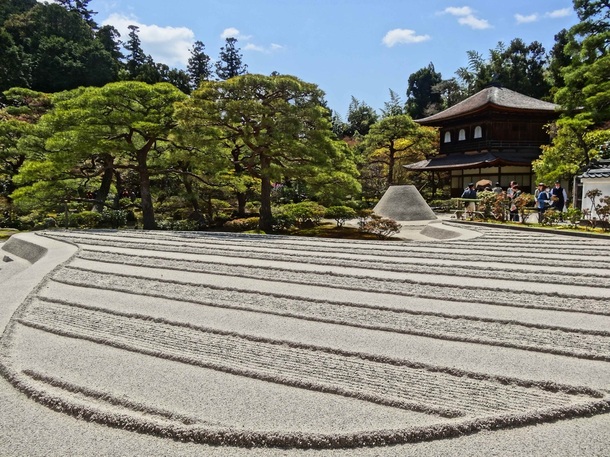
Ginsyaden Garden in Ginkakuji - the Temple of the Silver Pagoda
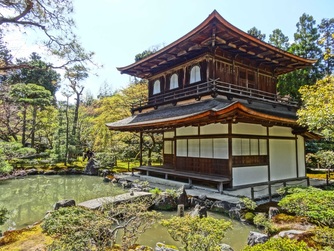
Our first Zen temple was Ginkakuji, sometimes called the Temple of the Silver Pagoda. Built in 1482 as a retirement villa for Ashikaga Yoshimasa, the aged, bared wood of the two story pagoda sits serenely overlooking a pond within an evergreen garden. Offset to the pavilion is the
Ginsyaden garden, a bare rock landscape sculpted to resemble waves and the Kogetsudi, a white sand funnel shaped like Mt. Fuji. In this garden we see
metaphor and reality playfully intertwined. The resemblance to an ocean and a mountain are unmistakable in the forms of the rocks, and yet are they not just rocks? The Zen garden invites us to see how we assign meaning to everything in our world while also prompting us to see the emptiness of that meaning. It is not a denial of meaning so much as recognition that sitting alongside our world of meaning is one much simpler and straightforward – the world simply as it is. Despite its apparent clarity, it can actually be quite difficult to see this world as it is – we so easily fall back into only our world of constructed meaning.
A visit to Kiyomizu Temple challenged how dedicated we must be in order to see this world as it is. The temple is built on a steep cliff in eastern Kyoto with its main porch and altar facing directly off a 50 foot drop onto the ground below. It calls to mind a famous
Zen Koan, by Mumon: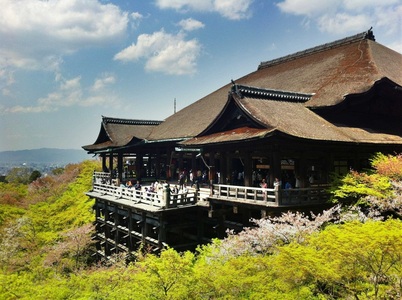
“There is a man on top of a hundred-foot pole. Though he has a degree of understanding, he's not yet a man of the Way. From the top of the hundred-foot pole he should advance a step further and the ten directions of the world will be his entire body."
In this koan, a man climbs to the top of a 100 foot pole and is told by his teacher that to advance to enlightenment, he must just climb a step further up the pole, which of course doesn’t exist. Or does it? The implication is that to see the world as it is, we must be willing to cast off our closely held ideas of reality and take the plunge into the unknown, leaving body and mind on the pole, as it were. In the case of Kiyomizu, this may have been taken a bit too literally. It was believed that jumping off the porch would grant the jumper a wish. During the Edo period, 234 jumps were recorded, but only 85.4% survived. Ouch.
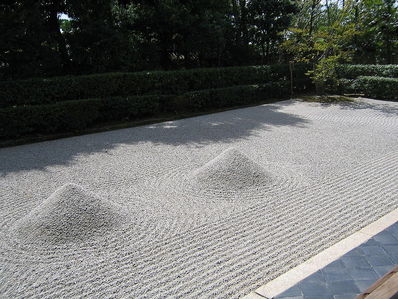
Next we visited Daisen-In Temple, which is within the Daitoku-ji Temple complex in northern Kyoto. The Muromachi period garden is famous for its metaphorical representation of the human lifecycle, starting from the vividly three-dimensional Mt. Horai (land of the immortals in Daoism) and moving past various symbolic naturalistic representations of the lessons we must learn to move towards enlightenment. A turtle-shaped rock, for example, appears to flow against the stream of the river, symbolizing the futility of fighting time, while a treasure boat shaped rock floats serenely with the river towards the Great Ocean. It is this ocean that was most captivating to me, a long stretch of carefully raked pebbles broken by only 3 objects. Closest to the viewer are two conical piles of stones rising out of the sea. They represent our brief moment of individuation from the Great Ocean. Beyond them, in the far corner sits a small bodhi tree. The message was vivid to me - we must return to the ocean, allow ourselves to dissolve back into the Great Sea, to find the other shore of enlightenment. Perhaps Zen master Tessho said it best in his death poem:
Finally out of reach -
No bondage, no dependency.
How calm the ocean,
Towering the void.
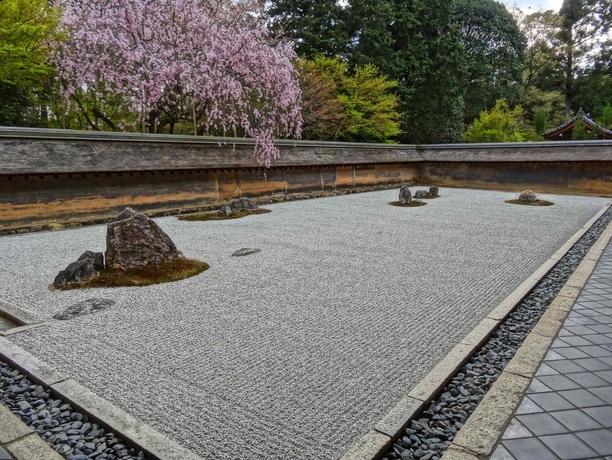
Ryoanji Zen Garden
Our last rock garden was perhaps the most famous, the 15 stones of Ryoanji. Here we come full circle, for the rocks at Ryoan-ji are said to represent nothing at all in the natural or mythical world. Here a rock is just a rock. The composition of the stones was designed to absorb the viewer, making him/her more conducive to the meditative state. We leave the realm of metahpor that our ego-minds dwell in 24/7 and come fully to this moment. In the end, no level of thought can help us to arrive there. But the message of Ryoan-ji is that inspiration towards “suchness” is to be found in all the myriad forms that surround us in day to day life. If there is “good news” in Buddhism, it is this. The world is full of suffering, yes – but it also offers infinite pathways to freedom and the relief of that suffering.
In the end the paradox of the Zen Garden is that they represent BOTH nothing AND something. It is to live simultaneously BOTH in this world of meaning AND in the world of suchness. Some early historians mistook Zen for a nihilistic tradition, but the truth is that Zen is not a tradition of neither/nor, but rather one of both/and.
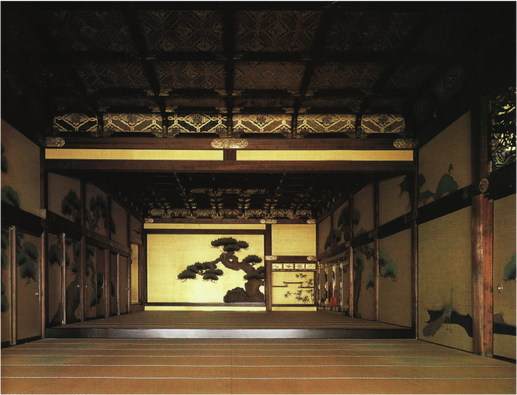
Kano naturalistic paintings on the walls of Nijo Palace. It is here that the Shogun met with his daimyo.
Beyond the inspiration of the gardens our time in Kyoto was full of historical sites as well. We enjoyed the architectural paranoia built into Nijo castle with its “nightingale floors,” which are designed to squeak like the little birds with even the slightest footfall. Built by the great shogun Tokugawa Ieyasu, founder of the long-lasting Tokugawa Shogunate, the palace shows the fear that even great leaders lived under in feudal era Japan. But it also demonstrates the beauty they lived with, as represented by the captivating naturalistic paintings of the Kano painters and the
intricate gardens on the grounds.
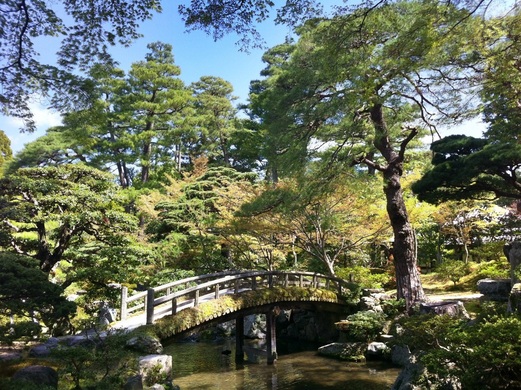
The Emperor's Private Garden at the Kyoto Imperial Palace
Being home to the Emperor for so long,
Kyoto’s Imperial Palace was also fun to stroll around, particularly to see the beauty of the Gonaitei, the Emperor’s private garden and the Oikeniwa, a stroll garden that offers different perspectives as you walk. The buildings themselves were largely reconstructed after fire in 1855, but were still interesting because of the relationship between the Emperor and Shogun during this time. The
Emperor was effectively held hostage to the shogun’s demands over a 500 year period, sometimes even having to sign an “Imperial Decree” just to feed the royal family.
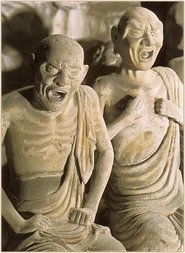
From Kyoto we spent a few days in Nara, the first capital of Imperial Japan from 710-784. The most notable sight lies outside the city in the form of the first Buddhist Temple ever built in Japan – Horyuji. Its builder, Prince Shōtoku, is still venerated in Japan as the progenitor of Japanese Buddhism. It contains the world’s oldest surviving wooden structures, dating from 711. Our tour with a local guide who was practicing his English gave us innumerable insights into the majestic old pagoda, which features various Buddhist scenes at its base. The most striking scene is that of the death of the Buddha, where his disciples are depicted as agony stricken over the loss of their teacher.
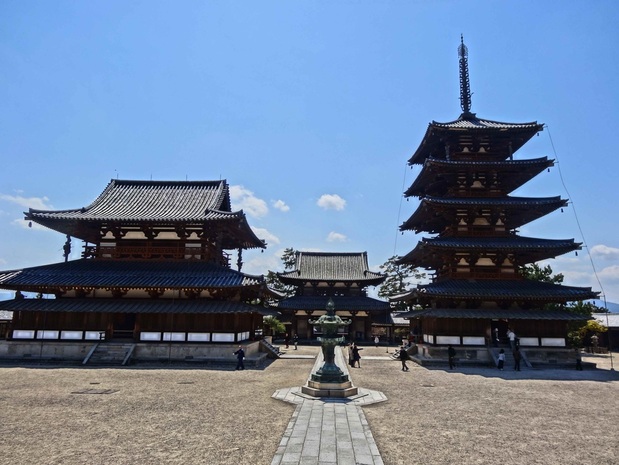
The oldest wooden buildings in the world at the Horyuji Temple outside of Nara
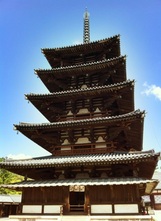
Japan experiences over 1000 earthquakes a year, a fact brought home to us as we awoke at 5:30 in the morning to our swaying hotel as a 6.3 magnitude shake reverberated out from Osaka. Pretty scary when you’re on the 12th (and top) floor of a hotel! Amazingly, the Pagoda’s engineering has made it impervious to such quakes over the centuries, leading its engineering principles to be studied and replicated in modern-day buildings.
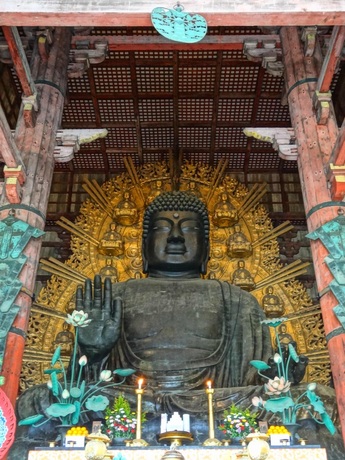
The massive Daibutsu statue
The other highlight of Nara is Todai-ji temple, which contains the Great Buddha Hall, or Daibutsuden. It was reconstructed in 1709 and its predecessor was said to be 30% larger still than the current building, which already ranks as the largest wooden structure in the world! But the real highlight is what the Great Buddha Hall houses...a Great Buddha of course! Towering 52 feet high, the Daibutsu is made up of 437 tons of bronze, 286 pounds of pure gold, and 7 tons of vegetable wax. It was commissioned by Emperor Shomu, who believed that if all the people of Japan joined together to make this Buddha image, it would encourage the Buddha to protect their kingdom. As a result, more than 2.6 million people worked on the construction of the Buddha and the hall over the years it took to build the structure and the eight castings required to get the bronze to take shape. In the end it nearly bankrupted the kingdom, so maybe the Buddha was sending a message that he doesn’t care too much about giant images, particularly since he explicitly said not to worship him after his death...tsk, tsk Emperor Shomu!
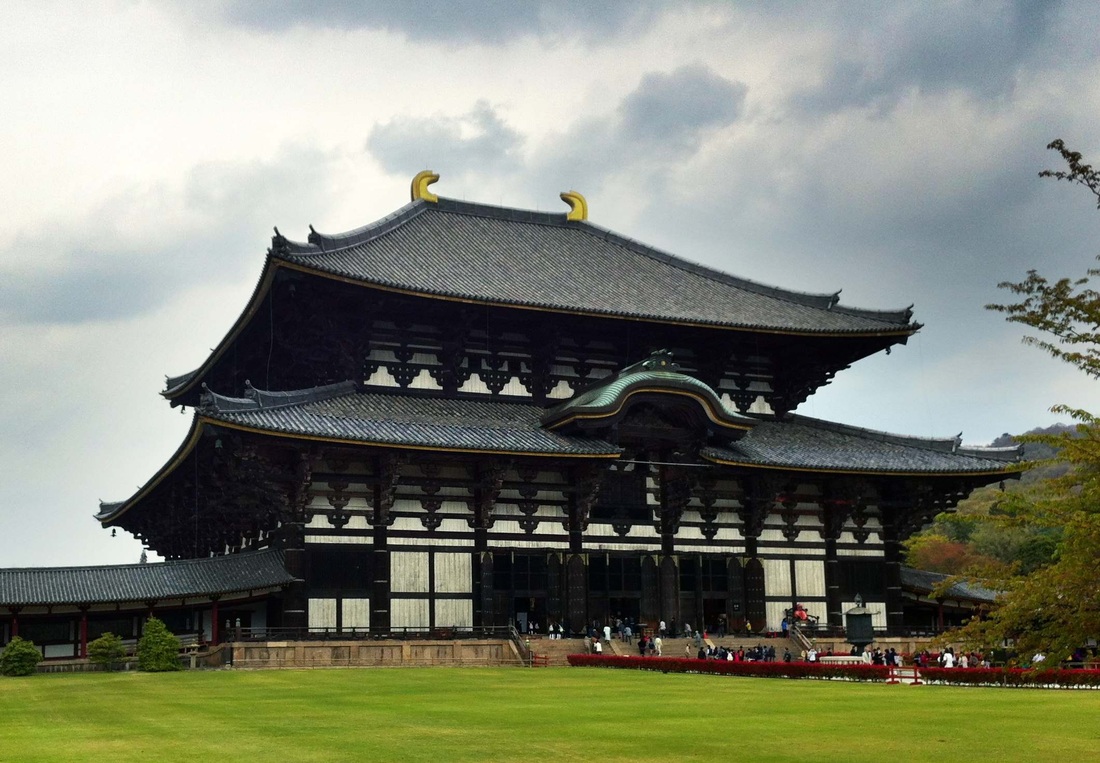
The Great Buddha Hall, or Daibutsuden in Todai-ji is the largest wooden structure in the world and holds the worlds largest bronze Buddha image (above)
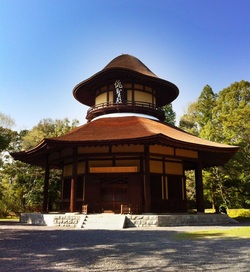
Haiseiden - Basho Memorial
Our last real tourist stop in Japan was the birthplace of Matsuo Basho, the famous Zen poet who we featured in our
Tokyo post. The town features several museums on Basho as well as his childhood home, but unfortunately all of them are in Japanese. Fortunately, there was another tourist attraction nearby that didn’t require much English because Iga-Ueno is also famed as the birthplace of Ninjitsu! During the month of April the city hosts a Ninja festival where everyone in the town is invited to dress up as a ninja (for a $10 fee) and test themselves with various feats of agility and dexterity. While we had had enough dress up for one trip with
our samurai and kimono stint, we had a great time watching the kids and marveling at the little ninjas the town had discretely placed all along the street.
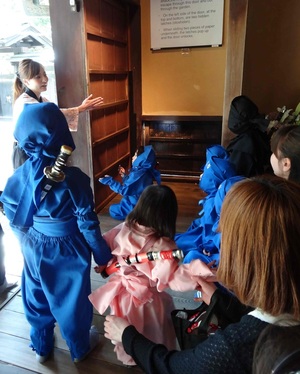
Ninja house tour with little ninjas
We also enjoyed the Iga Ninja museum, where we learned about the way Iga-Ryu Ninjas trained and practiced. Apparently, it was common for them to disguise themselves as farmers until called upon by a liege lord to commit an act of espionage - be it reconnaissance, diversionary tactics, or assassination. As such, they would combine typical farmer’s scythes to make grappling hooks and had interesting ways of hiding their weapons. This was really emphasized in the tour of a typical ninja house, which is full of
hidden doors and
escape passageways that aim to provide the ninja a fast exist but also to hide his secret technique for producing gunpowder (a powerful military secret at the time). Of course, no ninja museum is complete without a live show performance featuring shuriken throwing and mock fighting.
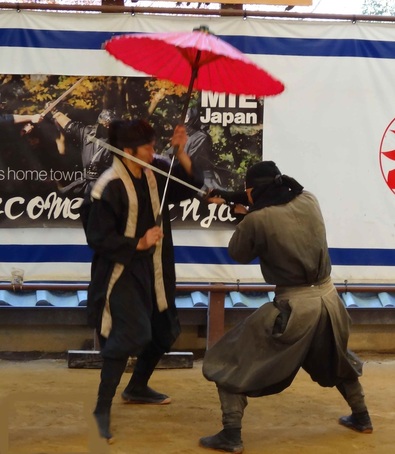
Mock ninja fight showing how an umbrella could conceal a sword! Segoi! (Japanese for amazing)
The ninja festival was too cute to not include a few extra pics. Here are some of our favorites:
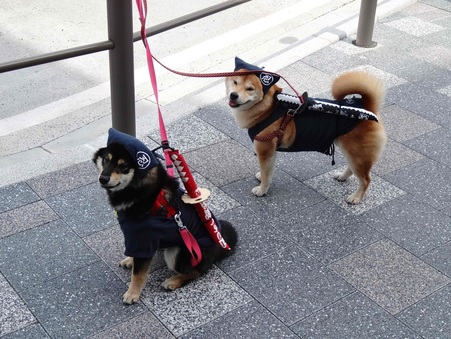
Japanese folks had some pretty intricate costumes for their dogs, but I think this took the cake for cutest
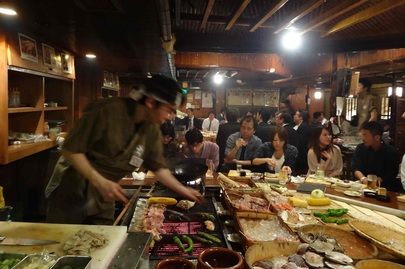
Izakaya in action
Finally, it was time to turn the page on our Japanese adventure. We headed to the city of Osaka excited due to its reputation as the food capital of Japan. It didn’t disappoint as we ate our fill of
sushi-train (invented in Osaka along with the instant noodle in 1958),
okonomiyaki (also invented there), and izakaya foods. The izakaya we enjoyed with a couchsurfer named Nathan who was living in Osaka and agreed to meet up with us to show us around town a bit. Izakaya is basically live action grilling combined with the consumption of large amounts of beer. What’s not to like? After dinner, Nathan showed us a cool little
brew bar that served up delicious cask-pulled IPA’s and stouts.
Thanks buddy! We also enjoyed the parks around Osaka Castle and particularly the Japanese mint as it contained a variety of late blooming double-pedaled cherry blossoms that gave us yet another glimpse of these wonderful trees so important to the Japanese national psyche.
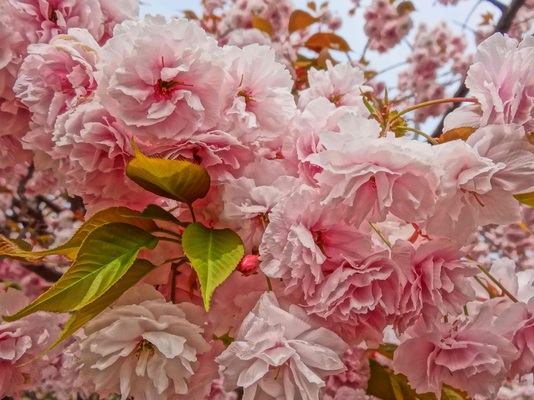
The "Torinuke", or Cherry Blossom Tunnel outside the Osaka Mint is renowned for its late blooming double petal varieties of the cherry blossom
Our time in Japan was full of rich experiences – from the reminders of our cherry blossom nature to connections beyond words with our Japanese family in Shiojiri. From the historical pensiveness engendered by Hiroshima to the contemplation stimulated by the gardens of Kyoto. We feel nostalgic about our time here but are also excited as we head to Japan’s neighbor, South Korea, for a 6 day stopover for some Seoul food! See you there!
















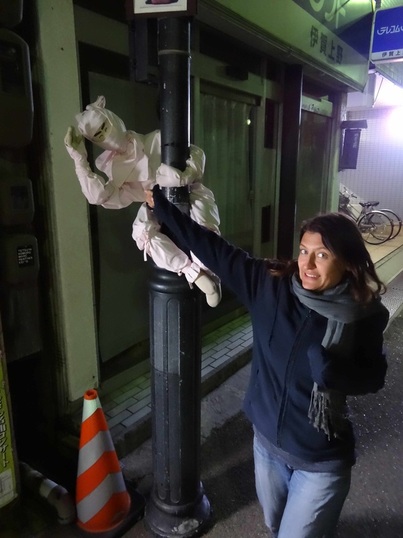


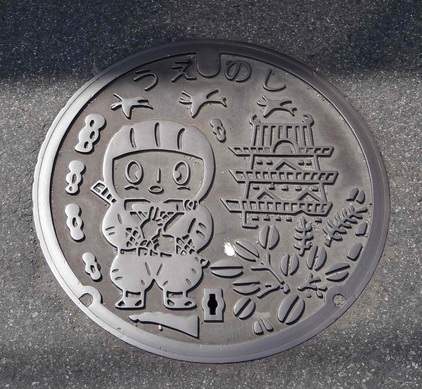

 RSS Feed
RSS Feed
